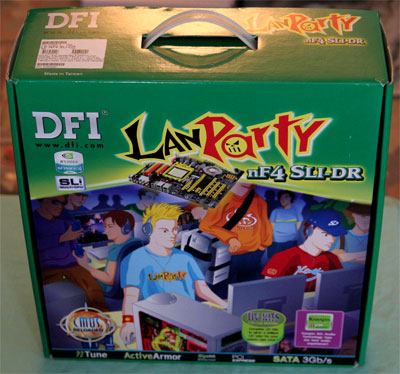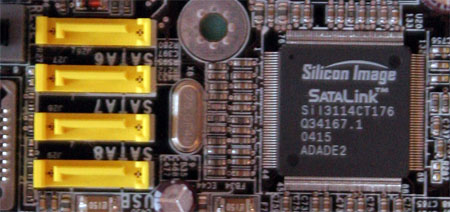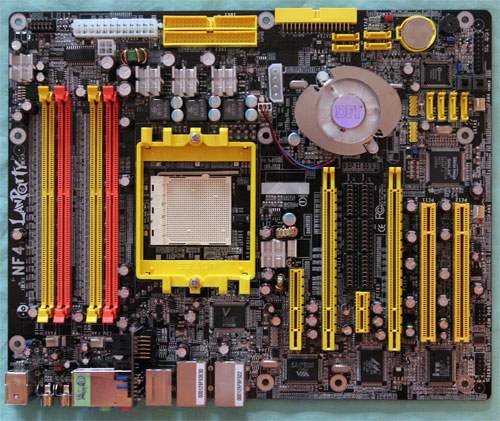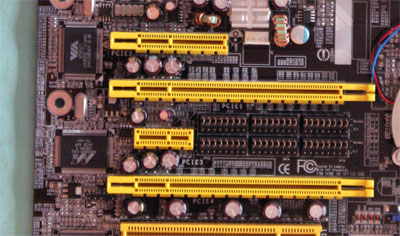nForce4 SLI Roundup: Painful and Rewarding
by Wesley Fink on February 28, 2005 7:00 AM EST- Posted in
- Motherboards
DFI LANParty nF4 SLI-DR: Features and Layout
| Specification | DFI LANParty nF4 SLI-DR |
| CPU Interface | Socket 939 Athlon 64 |
| Chipset | nForce4 SLI (single chip) |
| BUS Speeds | 200MHz to 456MHz (in 1MHz increments) |
| PCI/AGP Speeds | Asynchronous (Fixed) |
| PCI Speeds | 100MHz to 145MHz in 1MHz increments |
| Core Voltage | Auto, 0.8V to 1.55V in 0.025V increments (Normal) PLUS *104%, 110%, 113%, 123%, 126%, 133%, 136% (Special - to 1.85V) |
| CPU Startup Voltage | Startup, 0.825V to 1.550V in 0.025V increments |
| DRAM Voltage | 2.5V to 3.2V in 0.1V increments (3V jumper) 2.5V to 4.0V in 0.1V increments (5V jumper) |
| Chipset Voltage | 1.5V, 1.6V, 1.7V, 1.8V |
| Hyper Transport Ratios | Auto, 1.0, 1.5, 2.0, 2.5, 3.0, 4.0, 5.0 |
| LDT Bus Transfer | 16/16, 16/8, 8/16, 8/8 |
| LDT Voltage | 1.2V, 1.3V, 1..4V, 1.5V |
| CPU Ratios | Auto, 4x to 25x in 0.5x increments |
| Cool'n'Quiet MAX FID | Auto, 8.0 to 13.0 in 0.5x increments |
| DRAM Speeds | Auto, 100, 120, 133, 140, 150, 166, 180, 200 |
| Memory Command Rate | Auto, 1T, 2T |
| Memory Slots | Four 184-pin DDR Dual-Channel Slots Unbuffered ECC or non-ECC Memory to 4GB Total |
| Expansion Slots | 2 x16 PCIe Slots 1 x4 PCIe 1 x1 PCIe 2 PCI Slots |
| SLI Setup | Six 16-pin Jumper Blocks |
| Onboard SATA | 4-Drive SATA 2 by nF4 PLUS 4-Drive SATA by Sil3114 |
| Onboard IDE | Two Standard nVidia ATA133/100/66 (4 drives) |
| SATA/IDE RAID | 4-Drive SATA 2 PLUS 4-Drive IDE (8 total) Can be combined in RAID 0, 1 PLUS 4-Drive SATA by Sil3114 Sil3114 Raid 0, 1, 5 |
| Onboard USB 2.0/IEEE-1394 | 10 USB 2.0 ports supported nF4 2 1394A FireWire ports by VIA VT6307 |
| Onboard LAN | Dual Gigabit Ethernet PCIe by Vitesse VSC8201 PHY PCI by Marvel 88E8001 |
| Onboard Audio | Karajan Audio Module based on Realtek ALC850 8-Channel codec with 6 UAJ audio jacks, CD-in, front audio, and coaxial SPDIF In and Out |
| Other Features | Power and Reset momentary switches |
| BIOS | Award 2/17/2005 Release |
The DFI boards all support the full range of nVidia nForce4 features including nVRAID, Active Armor, SATAII 3Gb/s drives, NCQ, any-drive IDE/SATA Raid, PCIe Gigabit LAN by a PHY Ethernet chip (plus an additional PCI Gigabit LAN), and the nTune utility.
Packaging for the full LANParty nF4 SLI-DR is typical LANParty.

DFI has continued with the Karajan Audio Module first introduced on their LANParty 925x. As you will see later in our audio tests, the Karajan module was a much better performer than what we expected when we first saw the onboard Realtek 850 codec. We still wish that DFI had been able to use the High Definition ALC880 or a similar chip instead of the more common ALC850. However, the Karajan Module on the DFI SLI does provide the lowest CPU overhead that we have seen on any board using the 850.
The ALC850 Codec provides four pairs of stereo outputs, with 5-Bit volume controls and multiple stereo and mono inputs, along with flexible mixing, and gain and mute functions. Two 50mW/20ohm headset audio amplifiers are integrated at Front-Out and Surround-Out, and both amplifiers are selectable for Front-Out, Line-In and Mic-In as a Universal Audio Jack.
You can find more information on the ALC850 at Realtek.
DFI provides a full selection of rear I/O ports. These include 6 programmable audio mini jacks plus coaxial SPDIF in and out connectors to support the Realtek ALC850. The back panel also includes PS2 mouse and keyboard, 1 standard Firewire (IEEE1394a), 6 USB, and two RJ45 Gigabit Ethernet. There are no rear ports for a Parallel Printer or serial devices, but there is an onboard header for an external serial device an IR header.

The four DIMM slots support up to 4GB of up to DDR400 memory in a Dual-Channel memory configuration. Dual-Channel 1 is DIMMs 1 and 3, and Dual-Channel 2 is DIMMs 2 and 4. DFI specifies support for both ECC and non-ECC unbuffered memory. Contacts at DFI advise that best overclocking is achieved with the dual-channel DIMMs in Sockets 2 and 4.
Board Layout
The DFI LANParty nF4 SLI-DR is very well arranged, with almost everything located where it works best. As you will see if you study the layouts of the other SLI boards, the DFI differs substantially in layout.The DFI nF4 place the CPU in the top center of the board and DIMMs at the top. This arrangement worked well in our testing and should work better (for those who change memory frequently) than in the crowded right-hand alternate location used on many boards.

There is plenty of room around the Socket 939, so most Heat sink/Fans should work fine. A Zalman 7000 overhung DIMM slot 4, but it still cleared our stock OCZ memory and memory could work in all slots.
The IDE connectors are at our preferred upper right edge of the motherboard, and the floppy connector is a board edge connector located on the right edge around the middle of the board. Both locations worked well in our testing.


Asus A8N-SLI Deluxe: Overclocking and Stress Testing
DFI LANParty nF4 SLI-DR: Overclocking and Stress Testing










108 Comments
View All Comments
fozzymatic - Tuesday, March 1, 2005 - link
"So, is SLI worth the cost and the effort? For some, the answer will be a definite no. The SLI boards still cost a great deal, setting up the system is still a daunting task, and the cost of two top-of-the-line video cards will be just too much for many to consider SLI to be a real option."I still do not understand why this argument is so popular. Why is the general assumption that purchasers of SLI capable boards will immediately want to jump into a dual-card config? The idea is flexibility. Sure, 2 6800's are expensive now, but they will inevitably get cheaper. So why not buy one now and then profit form your forward thinking later down the line when the price of a second card is cut in half and there are more SLI-supported games available. I concede that the mobos are 50$ more than a non-SLI board but, for 50$, I'll take the enhanced upgrade path. Out of the gate the SLI boards are the fastest single or double-card NF4 mobos available, so whats to lose?
justly - Monday, February 28, 2005 - link
Wesley, well done, although I have to admit I skipped over some of the pages describing the individual boards as I am not personnaly intrested in buying a SLI system.One thing about the bar graphs, it could have been a little easier to compare between a single card and SLI if you had used split bars like in this graph
http://images.anandtech.com/reviews/video/ATI/rade...
using the top half of the bar for single card and the bottom for duel cards.
It would also be nice to see a comparasion of disk controller, firewire and USB performance (and anything else that is chipset specific) using all the different brand chipsets.
I don't think you are the person that does power supply reviews, but with all the concerns recenty about power supplies it would also be nice to see an article that not only describes some of the differences in power supplies but what components draw power from what rails and how much they draw (I have seen power supply guides that give an idea of how many total watts is needed but very little information on how those watts are divided up between rails).
One last thing, I have a little problem with this statement "the ability of a motherboard to run at much higher than stock speeds tells you something about the quality of components used in a motherboard". If every motherboad had a perfect BIOS and they all had the same overclocking options then your statement could be true, but that is not the case. Would you call all Intel branded motherboards poor quality just because Intel doesn't put overclocking options in their motherboards BIOS? What if an OEM decided to use one of these great overclocking boards in a prebuilt system and the only change they made to the board was to eliminate the overclocking options from the BIOS, is that board now poor quality?
Viper4185 - Monday, February 28, 2005 - link
Well well well, seems you are right. The MSI nForce 4 Ultra board in Australia even has 1x PCI Express slot...http://www.msi.com.tw/program/products/mainboard/m...
Does anyone know which boards support Firewire 800 (1934b)?
Also to Wesley, thanks for the reply, do you have a rough idea when the nForce 4 Ultra comparison would be available?
falcc - Monday, February 28, 2005 - link
There seems to be different version of MSI's SLI boards depending on where you live. In Australia the SLI board is a MSI K8N Diamond. The interesting thing about this board is that it has two PCI Express x1 slots. as well as the two x16 slots for SLI. It also has a wlan option.falcc - Monday, February 28, 2005 - link
ChineseDemocracyGNR - Monday, February 28, 2005 - link
#43, I'm aware it needs a PHY, but I always thought it worked the same way as it did since the nForce3-250Gb, with no PCI-E involved.I checked out the manual for the MSI K8N Diamond and ASUS A8N-SLI, from them:
MSI
"Dual LAN
? Supports dual LAN jacks
- 1st LAN supports 10/100/1000 Fast Ethernet by nForce4 SLI
- 2nd PCI Express LAN supports 10/100/1000 Fast Ethernet by Marvell 88E8053"
ASUS
"nForce4 built-in Gbit MAC with external Marvell PHY :
- NV ActiveArmor
- NV Firewall
- AI NET2"
I couldn't find a reference that the chipset LAN is tied to PCI-E.
ajmiles - Monday, February 28, 2005 - link
Excellent, thanks Wesley. Every response I've had from now has been, quote:"With regards to the overclockability, it has AI Overclock, PEG link, and other options, the extent of the overclockability was not promised and unfortunately some customers expect amazing overclocking abilities when the 1T overclock is still a good feature and is overclocking in action."
Perhaps what you would expect them to say when their board clocks more than 60mhz lower than some competitors.
If you could keep me apprised of their response either here or at amiles(at)gmail.com that'd be great. Thanks again.
JoKeRr - Monday, February 28, 2005 - link
I really wish MSI could pump a bit more voltage for the ram, 2.85 is a bit low, especially considering the Asus is giving 3V and DFI is giving 4V!! Guess if u want to run your good old BH5 sticks at 250mhz 2-2-2-7, DFI will be the way to go. But I really liked the MSI mobo. o well, guess u can't have everything.JoKeRr - Monday, February 28, 2005 - link
Wesley Fink - Monday, February 28, 2005 - link
#6 & #56 - I saw the same behavior with the A8N-SLI Deluxe during our testing, and I shared my results with Asus. I forwarded your comments and my own to the Asus A8N-SLI BIOS and Engineering team.